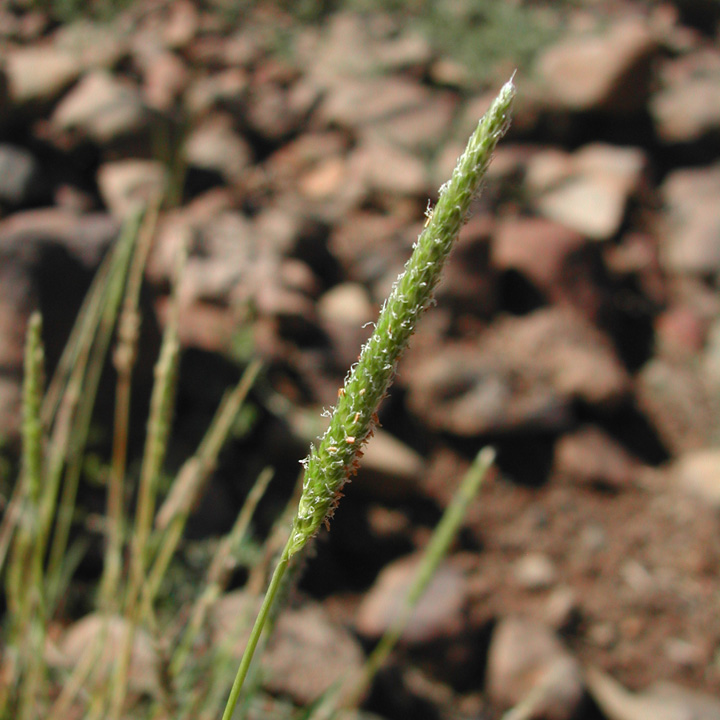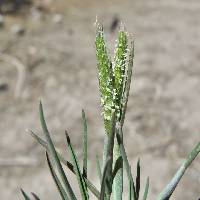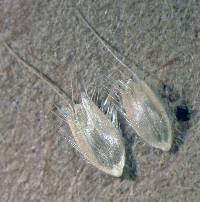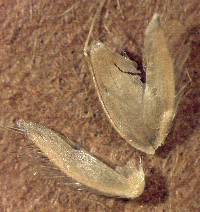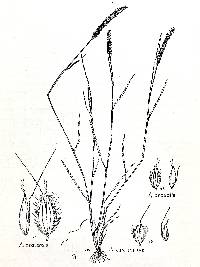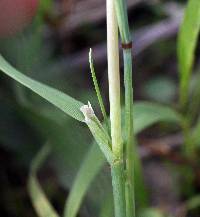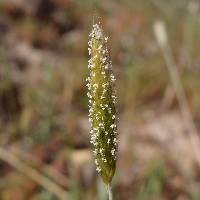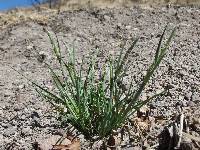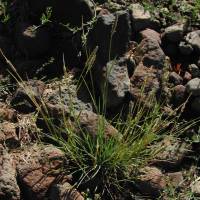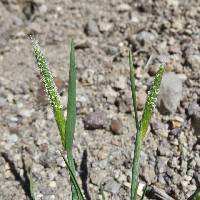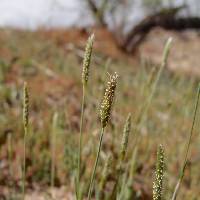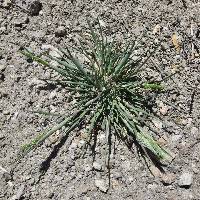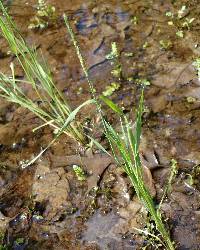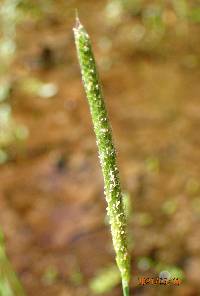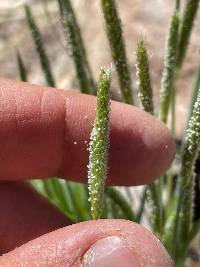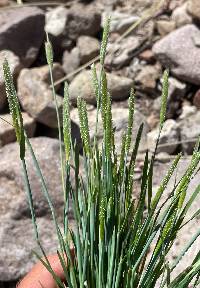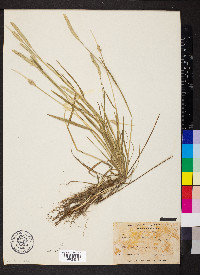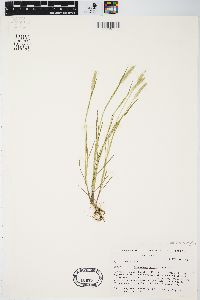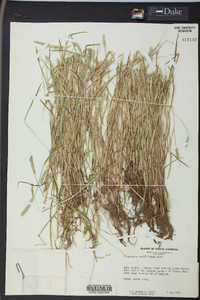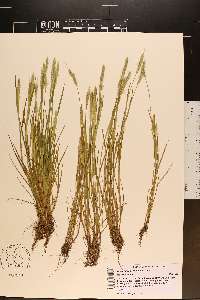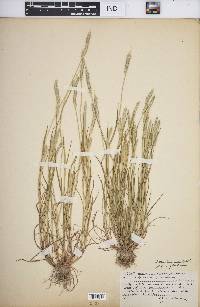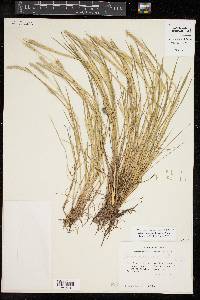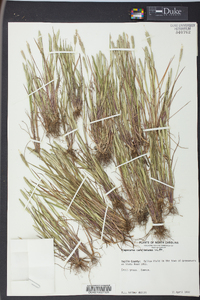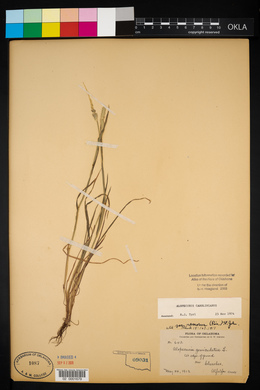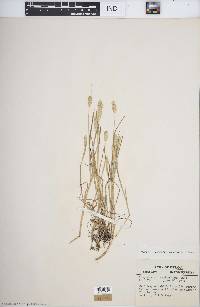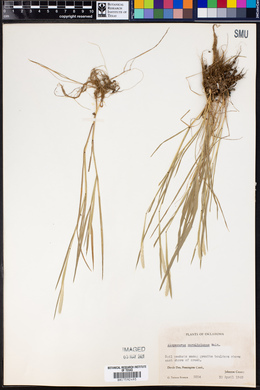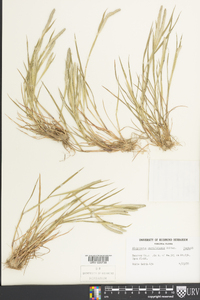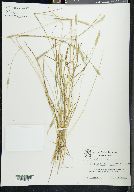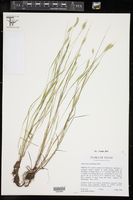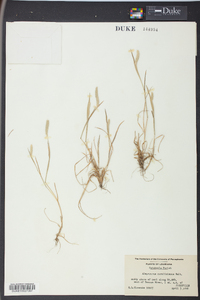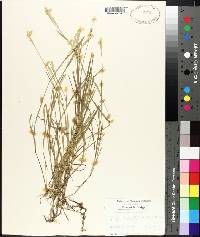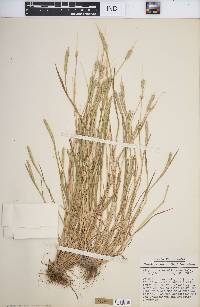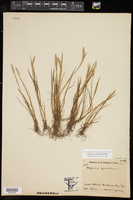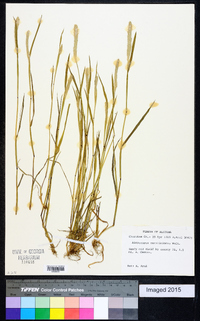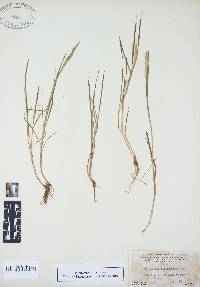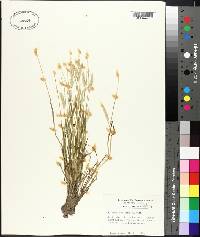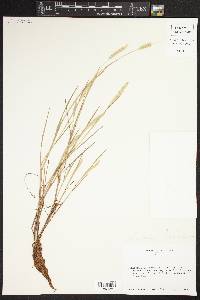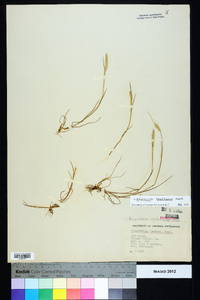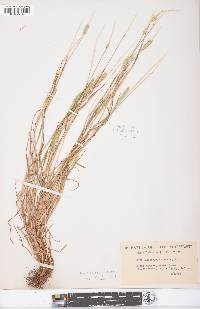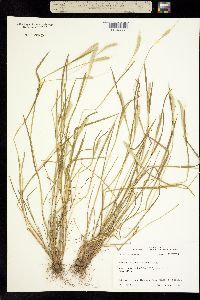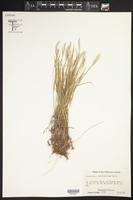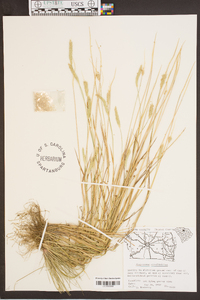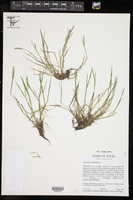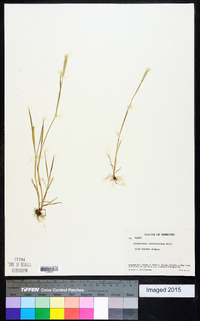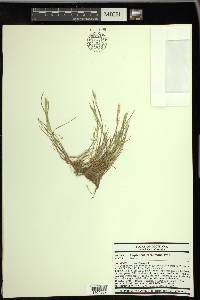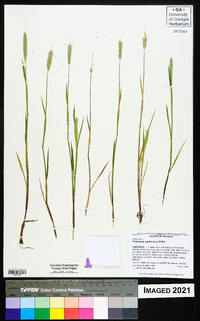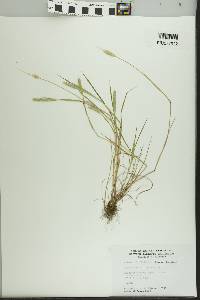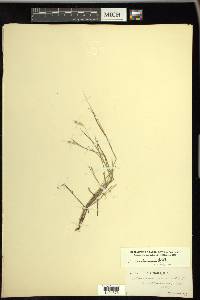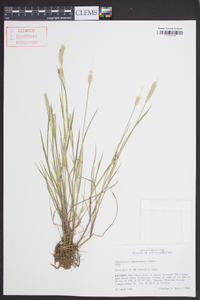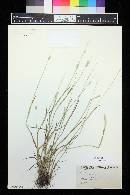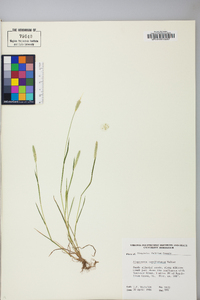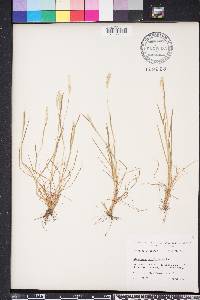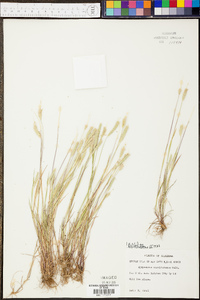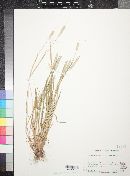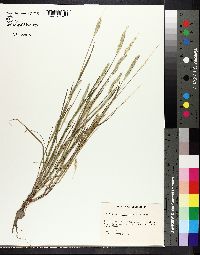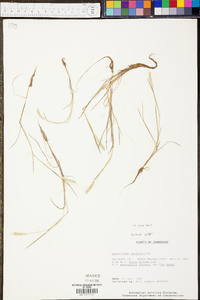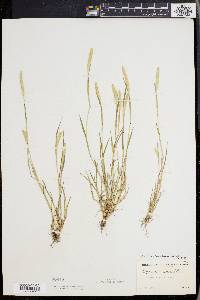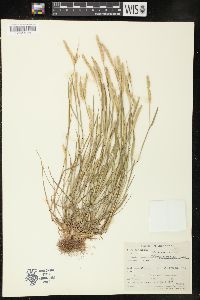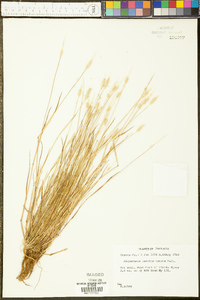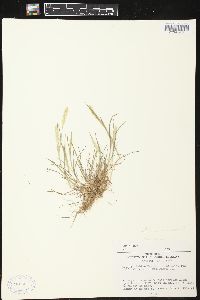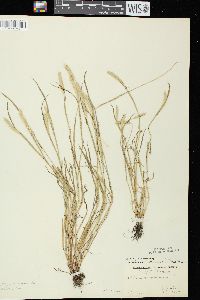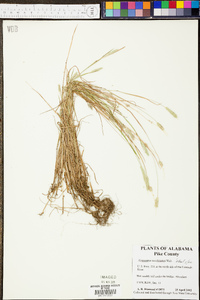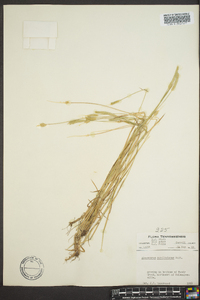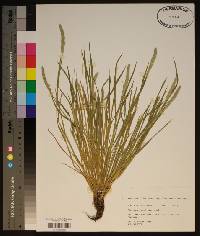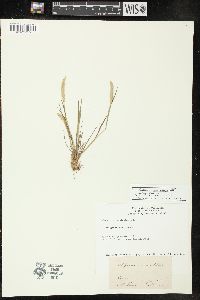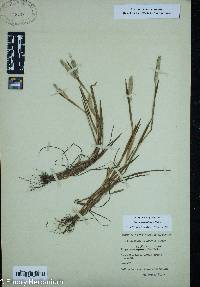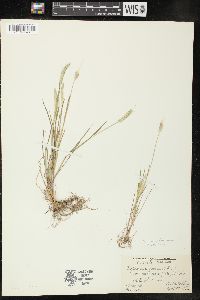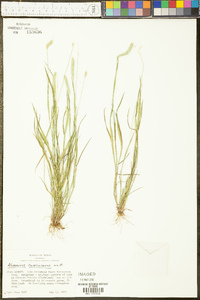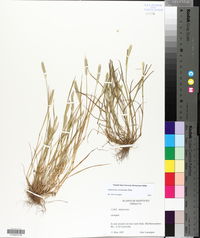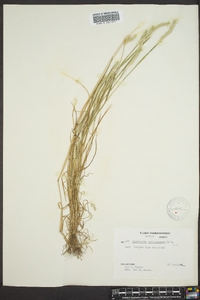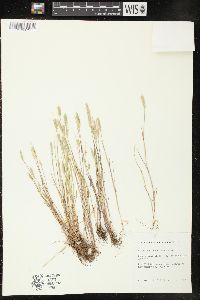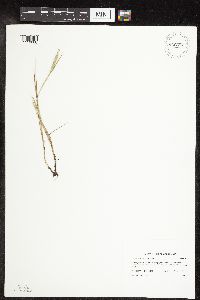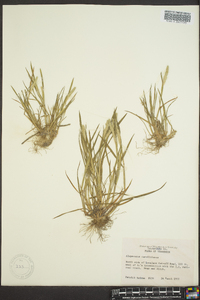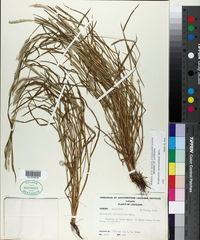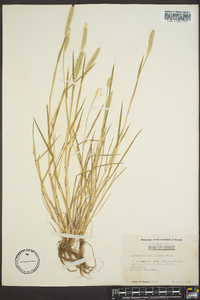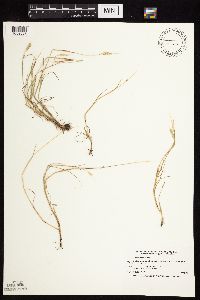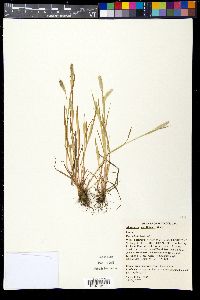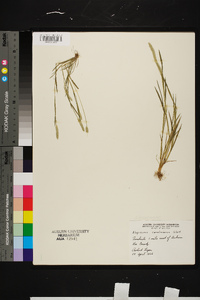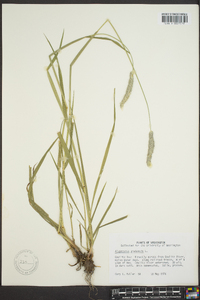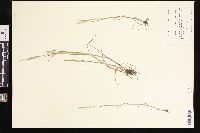Alopecurus carolinianus
|
|
|
|
Family: Poaceae
Tufted Meadow-Foxtail, more...Carolina foxtail, Tufted Foxtail
[Alopecurus geniculatus var. caespitosus Scribn., moreAlopecurus geniculatus var. ramosus (Poir.) H. St. John, Alopecurus gracilis Willd. ex Trin., Alopecurus macounii Vasey, Alopecurus pedalis Bosc ex P. Beauv., Alopecurus ramosus Poir.] |
Plants annual; tufted. Culms 5-50 cm, erect or decumbent. Ligules 2.8-4.5 mm, obtuse; blades 3-15 cm long, 0.9-3 mm wide; upper sheaths not inflated. Panicles 1-7 cm long, 3-6 mm wide, always dense. Glumes 2.1-3.1 mm, connate at the base, membranous throughout, sparsely pubescent, not inflated below, keels not winged, ciliate, apices obtuse, pale green to pale yellow; lemmas 1.9-2.7 mm, connate in the lower 1/2, glabrous, apices obtuse, awns 3-6.5 mm, geniculate, exceeding the lemmas by 1.6-4 mm; anthers 0.3-1 mm, yellow or orange. Caryopses 1-1.5 mm. 2n = 14. Alopecurus carolinianus is native to the central plains, Mississippi valley, and southeastern United States, where it is common in wet meadows, ditches, wetland edges, and other moist, open habitats; it is occasionally a weed of rice fields. At the northern limit of its range it is clearly adventive, growing in gardens and nurseries. It also occurs in arid areas of the prairies and southwest, growing sporadically along sloughs and in ditches and vernal pools. Whether such populations are native or naturalized is not clear. Dr. David Bogler, USDA NRCS PLANTS Database Annuals, Terrestrial, no t aquatic, Stems nodes swollen or brittle, Stems erect or ascending, Stems geniculate, decumbent, or lax, sometimes rooting at nodes, Stems caespitose, tufted, or clustered, Stems terete, round in cross section, or polygonal, Stem internodes hollow, Stems with inflorescence less than 1 m tall, Stems, culms, or scapes exceeding basal leaves, Leaves mostly cauline, Leaves conspicuously 2-ranked, distichous, Leaves sheathing at base, Leaf sheath mostly open, or loose, Leaf sheath smooth, glabrous, Leaf sheath and blade differentiated, Leaf blades linear, Leaf blades 2-10 mm wide, Leaf blades mostly flat, Leaf blades mostly glabrous, Ligule present, Ligule an unfringed eciliate membrane, Inflorescence terminal, Inflorescence a dense slender spike-like panicle or raceme, branches contracted, Inflorescence solitary, with 1 spike, fascicle, glomerule, head, or cluster per stem or culm, Inflorescence spike linear or cylindric, several times longer than wide, Inflorescence single raceme, fascicle or spike, Flowers bisexual, Spikelets pedicellate, Spikelets laterally compressed, Spikelet less than 3 mm wide, Spikelets with 1 fertile floret, Spikelets solitary at rachis nodes, Spikelets all alike and fertille, Spikelets bisexual, Spikelets disarticulating below the glumes, Rachilla or pedicel glabrous, Glumes present, empty bracts, Glumes 2 clearly present, Glumes equal or subequal, Glumes equal to or longer than adjacent lemma, Glume margins connate at base, Glumes keeled or winged, Glumes 3 nerved, Lemmas thin, chartaceous, hyaline, cartilaginous, or membranous, Lemma margins connate below, Lemma 5-7 nerved, Lemma glabrous, Lemma body or surface hairy, Lemma apex truncate, rounded, or obtuse, Lemma distinctly awned, more than 2-3 mm, Lemma with 1 awn, Lemma awn less than 1 cm long, Lemma awn 1-2 cm long, Lemma awn subapical or dorsal, Lemma awn once geniculate, bent once, Lemma margins thin, lying flat, Lemma straight, Stamens 3, Styles 1, Styles 2- fid, deeply 2-branched, Stigmas 2, Fruit - caryopsis, Caryopsis ellipsoid, longitudinally grooved, hilum long-linear.
FNA 2007, Gould 1980, Kearney and Peebles 1969, Hitchcock 1971 Common Name: Carolina foxtail Duration: Annual Nativity: Native Lifeform: Graminoid General: Tufted annual grass with erect or decumbent stems, 5-50 cm. Vegetative: Blades 3-15 cm long, 1-3 mm wide; ligules 3-4 mm, obtuse. Inflorescence: Dense, narrow, cylindric spikelike panicles 1-7 cm long, 3-6 mm wide; spikelets with 1 floret each; glumes 2-3 mm, connate at base, membranous throughout, sparsely pubescent, pale green to pale yellow; lemmas 2 mm, connate in lower half, glabrous, obtuse apices, awns 3-6.5 mm, geniculate, exceeding the lemmas by 1.5-4 mm. Ecology: Found in moist soils along wet meadows, streams, wetland edges from 4,500-7,500 ft (1372-2286 m); flowers May-July. Distribution: Common in central plains, Mississippi valley, and se US, where it is common. Sporadic in the sw US. Notes: This small tufted annual grass is distinctive due to its spike-like inflorescence densely packed with flowers. Each floret has a geniculate awn that is much longer than the glumes, but the awns are so narrow and delicate that to the naked eye they look like hairs. Similar to A. geniculatus but differing in being an annual and having a slightly more slender panicle. Ethnobotany: Unknown Etymology: Alopecurus comes from the Greek alopekouros, meaning a grass like a fox's tail, while carolinianus means of or from Carolina. Synonyms: Alopecurus macounii, A. ramosus Editor: SBuckley 2010, AHazelton Densely tufted annual 1-6 dm, erect or ascending to rarely decumbent at base; infl cylindric, 2-5 cm נ4-5 mm; spikelets 2-2.4 mm; glumes connate only at the base, scarious and erose at the blunt tip, villous-ciliate on the keel, ±villous on the sides and base; awn attached halfway between the base and the middle of the lemma, ±geniculate, exserted 1.5-3 mm; anthers 0.3-0.7 mm; 2n=14. Wet soil; Mass. to Minn., s. to Fla. and Tex., and w. to the Pacific. Gleason, Henry A. & Cronquist, Arthur J. 1991. Manual of vascular plants of northeastern United States and adjacent Canada. lxxv + 910 pp. ©The New York Botanical Garden. All rights reserved. Used by permission. From Flora of Indiana (1940) by Charles C. Deam Infrequent to local in the greater part of the state. In the northern part it is found in mucky soil about ponds and in ditches, and in the southern part it is usually found in slightly acid, white clay soil in fallow fields, and usually associated with one or more of the following plants: Poa Chapmaniana, Agrostis hyemalis, Myosotis virginica, and Arabis virginica. ...... Indiana Coefficient of Conservatism: C = 0 Wetland Indicator Status: FACW Diagnostic Traits: Inflorescence densely spike-like; spikelets 1-flowered, flat, <3 mm long; lemmas 5-veined, their awn arising from near base of lemma and often extending 2-3 mm beyond glumes. |
|
|
|

